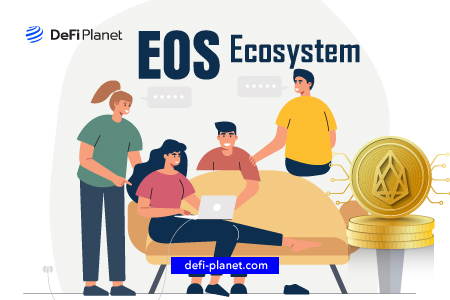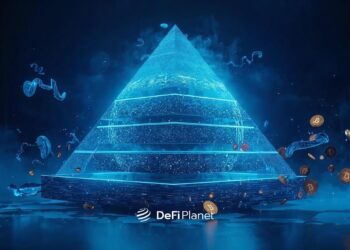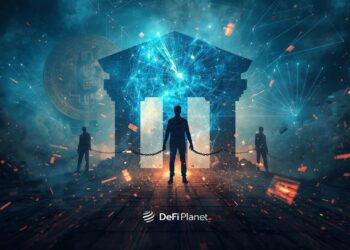Several blockchains have emerged to compete with Ethereum and address the latter’s shortcomings. EOS is one of them, and it was founded in 2018 to provide developers with an innovative set of tools for building decentralized apps.
Ethereum has long struggled with overlooked scalability issues. These concerns are said to be resolved by the upcoming ETH 2.0. But in the meantime, blockchains such as EOS have been created to address them.
Two underlying concepts of blockchain technology that have been leveraged to give it an advantage over traditional platforms include fast transaction speeds and low costs. But scalability concerns have seemed to erode these concepts and prevent consumers from adopting blockchain technology.
The proponents of EOS thought of how they could solve the slow transaction speed and exorbitant fees of Ethereum and opted to incorporate both horizontal and vertical scaling.
EOS observed that the concept of decentralized apps could not be overlooked because many developers want to build their apps around a blockchain rather than a single device that is prone to failure.
Many users have explored Ethereum because of its smart contract feature, user authentication, and other functionalities though they have grown apprehensive due to scalability difficulties.
A notable blockchain development company, Block.one decided that it was time to launch its blockchain which would solve the issues observed in Ethereum.
Daniel Larimer is one of the leaders in the crypto space and has been instrumental in the development of EOS.
EOS is not his first foray into the crypto space, as he was actively involved in the development of Steemit, Bitshares, and many other projects. He is the CTO of the parent firm, Block.one. He shows significant interest in the DAO concept.
A Comparison With Ethereum
EOS provides features similar to those found in the Ethereum ecosystem, the forerunner of smart contract technology. The former intends to provide functionalities not found in the Ethereum blockchain. For instance, “EOS can execute around 4000 transactions per second with an average confirmation time of 0.5 seconds or 500 milliseconds,” for example.
It is important to note that EOS is working on this, and has not achieved this incredible transaction speed yet. If the team can achieve this feat, it will revolutionize decentralized apps and the blockchain world in general.
It is crucial to note that EOS is still working on this and has not yet achieved this remarkable transaction speed. If the team is successful, it will revolutionize decentralized apps and the blockchain industry.
When Ethereum was launched, it didn’t have scalability difficulties because there were just a few dApps on the chain. But as the number of dApps grew exponentially, the story changed. Slow transaction speeds affected apps, developers, and users, causing performance bottlenecks. EOS intends to utilize innovative features such as asynchronous communication and parallel execution to address this problem.
To ensure that no two modules do the same thing, slowing down transaction speed, each module in the chain performs distinct functions to ensure that decentralized apps run effectively. This implies that the module responsible for a specific activity will not execute the role of its counterpart.
Developers are a vital component of the ecosystem, and EOS has included several usability features to help them build apps and protocols on the blockchain more effectively.
Consensus Mechanism
EOS is not a Proof-of-Work (PoW) network like Ethereum; instead, it adopted a more environmentally friendly consensus mechanism in which some blocks are created by the producers in exchange for a reward for their services. The rewards are EOS tokens.
Although producers are allowed to pitch the number of rewards they earn, a check has been put in place to ensure that this freedom is not misused. The check and balance system limits the percentage increase in their incentives to 5%, which means that producers are not allowed to increase their reward above the limit.
Every major decision within the ecosystem is reached through a voting process, and the user must have EOS tokens to be eligible. They have the option of removing any block producer that requests an excessive increase in the reward rate.
Increased demand for block producers’ services can result in an increase in their income as their value within the ecosystem increases. It is common to notice a rise in demand when community members request additional storage space, implying that producers will have to put in more time to create extra blocks. An increase in the reward rate is determined by the votes of token holders. If the demand for storage space reduces, the opposite will happen.
A great deal of what happens in EOS is determined by the block producers, as they have the chance to vote on proposals and modifications. They can decide on how transactions should be validated, the state of an app, bugs fixes, platform updates, and much more. Block producers have massive control over what happens in the blockchain.
EOS Architectural Model
• Low Computing Power
Ethereum, like Bitcoin, is a Proof-of-Work blockchain that consumes a lot of energy, while EOS isn’t. EOS does not require enormous computer power or energy like the others because it utilizes a DPOS consensus mechanism.
• Innovative Smart Contract Technology
Block.one realized that smart contracts were here to stay and opted to add them into EOS, which developers appreciated.
In EOS, smart contract users can create a customized permission system to protect a specific component of the smart contract. The addition of flexibility to smart contracts makes it simple for developers to build innovative platforms.
• Scalability
One of EOS’s primary selling features is its excellent scalability, which outperforms many other blockchains and has been attributed to its consensus process, the DPoS- Delegated Proof-of-Stake mechanism. Parallel execution and asynchronous communication are two more scaling innovations that it invented. Asynchronous communication implies that everyone does not have to be present at the same time to communicate.
• Unlimited Token Supply
When viewed from two perspectives, one can see the benefits and drawbacks of this. The founders claim they created it this way to prevent the hyper-valuation of EOS since they want it to be readily accessible to anyone who wants to build or use its features.
On the other hand, it may deter individuals from building innovative products because an unlimited supply of a token equals inflation, which is worrisome.
• High Level of Security
A large portion of EOS’s features is aimed towards resolving Ethereum’s problems. The Ethereum team was forced to do a hard fork after being hacked and millions of ETH stolen. A school of thought at the time believed that doing so invalidated the concept of immutability.
EOS asserts that such concerns would not exist on its chain since it employs a different consensus mechanism, DPOS. If an attack occurs, the decentralized app under attack will be frozen until the situation stabilizes.
Innovative Cloud Storage System
EOS was designed with developers and decentralized apps in mind, hence, it offers cloud storage and server hosting. EOS has attracted more developers to the ecosystem by incorporating these features, resulting in rapid growth.
With EOS, developers can focus on core issues such as dApp development rather than worrying about storage space, hosting, bandwidth, etc.
After hosting their apps on EOS, developers can utilize the ecosystem’s analytics services to track the performance of their decentralized apps. This helps them determine which components of the system require modification.
A Snag In EOS Architecture
Because of the block producer feature, crypto enthusiasts have expressed concern that EOS might become a breeding ground for centralized tendencies. Whales tend to have more tokens, which means they may utilize their enormous token holdings to influence what occurs in the ecosystem. They can vote on the amount of compensation that block producers should receive and who should hold the positions, establishing the concept of centralization indirectly.
In Conclusion,
EOS is filling gaps in the Ethereum chain and providing some of the features that the revamped ETH 2.0 is slated to provide.
If you would like to read more articles like this, follow DeFi Planet on Twitter, LinkedIn and Facebook.





















